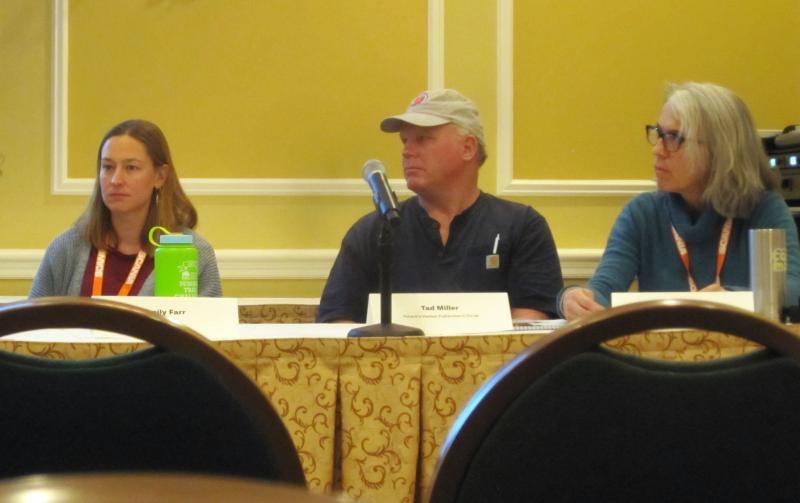Emergency legislation could bring funds to rebuild damaged working waterfront

ROCKPORT – Department of Marine Resources Commissioner Patrick Keliher opened a seminar on working waterfront at the Fisherman’s Forum March 2 to assure he is pushing for state money to help the fishing industry rebuild infrastructure on the coast destroyed or damaged by back-to-back storms in January.
Keliher said he is looking for half of the $50 million in proposed State emergency legislation to be targeted for rebuilding privately-owned wharves, buildings and other working waterfront facilities. Bill No. 2225 targets funds to public and regionally significant infrastructure as well as “private infrastructure upgrades with significant community benefits, such as working waterfronts.” If approved, the money would come from an already established State reserve fund.
At a March 6 public hearing on the bill in Augusta, members of the local fishing community submitted written testimony in favor of the bill and described destruction to wharves, buildings and equipment used to bring in fish, lobster, aquaculture products and bait.
Those who testified included Gerry Cushman, President of Port Clyde Fisherman’s Co-op, Tad Miller a wharf owner, and a fisherman around Matinicus Island and Tenants Harbor, James Wotton, co-owner of Friendship Lobster Co-op and Gigi Lirot, representing Whitehead Light Station.
Wotton said Cranberry Island was hit the hardest and five communal docks in that area suffered extreme damage. Lirot described destruction at the Whitehead Light Station off of Spruce Head. The 150-year old boat house and dock used to access the island were destroyed, she said. Miller said his family’s wharf at Tenants Harbor held up during the January storms, because it was rebuilt and elevated after a similar storm in 1978. But there was major erosion and damage around the harbor, he said.
Working Waterfronts and Coastal Access seminar
At the March 2 seminar, panelists were asked about the damage they saw from the January storm. They talked about wharves that were completely destroyed or substantially undermined, washed out water access routes and the worry that some structures used by the fishing community may never be rebuilt. They said there is little funding of any kind available for maintaining private wharves or water access routes critically important to businesses, individuals and communities.
Private businesses are generally not covered by federal and state Emergency Management Agency funds, which targets public property.
Worse still, panelists said they are hearing from property owners that insurance companies have denied claims submitted for destroyed or damaged wharves, roadways or footpaths that provide access to fishing areas and mudflats.
Monique Coombs, from Maine Coast Fishermen’s Associates, said that for the most part, the only existing funds are Small Business Administration low-interest loans, which would require flood insurance that could be cost prohibitive.
A man in the audience from Stonington said of his experience with insurance after the January storms, “you pay all this money for insurance for years and don’t get any money in return.” If a building burned down, that would be covered, he said. Including taxes, “you put a lot of money into this,” he said. “How much longer can we hang on?”
Originally, these panelists at the Fisherman’s Forum had not planned to talk about storm damage. They were prepared to share stories about their efforts to preserve working waterfront.
Miller described a long, difficult and expensive path he and family members have gone through to convert their privately-owned wharf and buildings on Tenants Harbor to ownership by the local fishermen’s co-op. This will involve the sale of the property to the Co-op. Miller believes the sale will be settled in the near future. The Tenants Harbor Fisherman’s Co-op is currently used by about 20 fisherman, including himself. While the sale is “not cheap” and “still a reach pricewise,” he said, it is a way to preserve access for fishermen. In the future, when other wharves in the area go up for sale and the owners are offered top dollar, these properties “will go private” and “can’t be gotten back,” he said.
Rebecca Rundquist, from Sea Meadow Marine Foundation, described a “tedious, expensive process” she has been involved with to protect a 4-acre parcel of working waterfront property on the Cousins River in Yarmouth. The property was the site of a lobster boat building business in the 1960s, and in the 1980s a business building trimarans. Sea Meadow purchased the property with a USDA loan in December 2021. The non-profit operates the property, described as a “tenant-led, collaborative working boat yard.”
Sea Meadow still faces challenges maintaining the property. One is a crumbling bulkhead on the shore. She said there is no funding available to pay for this.
Rundquist talked about preserving waterfront access for the local community for fishing, clamming, recreational and other uses. She brought up the figure, mentioned by other panelists, that only 22 miles of working waterfront remains on the Maine Coast. “The value is unquantifiable for our communities,” she said.
Coombs described working waterfront on the coast, not only as important to Maine’s seafood industries, economy and employment, but as containing the memories and histories of families and communities.
























